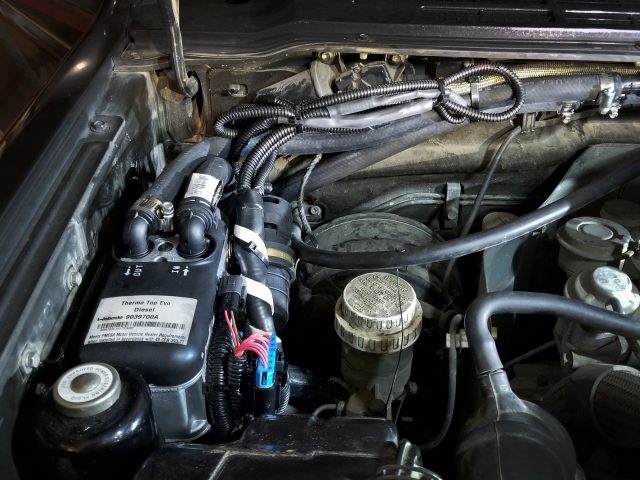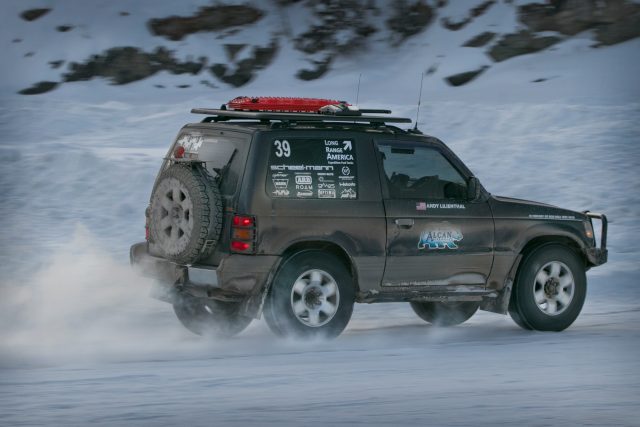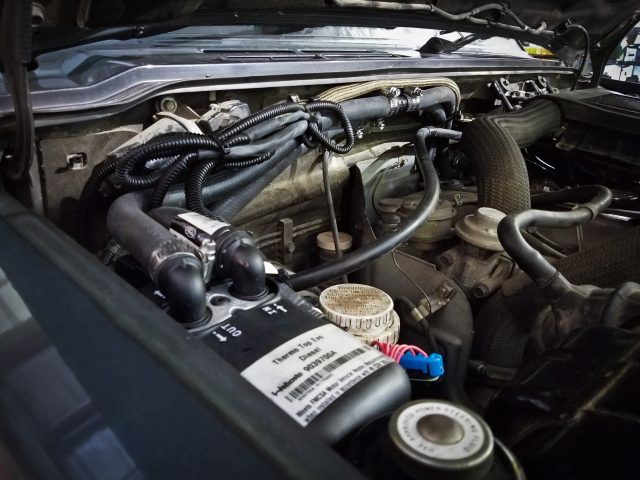Recently, my husband, Andy Lilienthal, and I rallied a 1991 Mitsubishi diesel-powered Pajero in the Alcan 5000 Rally. Not only did we pilot this right-hand-drive Japanese Domestic Market (JDM) 4×4 over 5,120 miles of ice, snow, and blizzard conditions, we had to ensure it started every morning after it slept in Arctic temps of -40° and beyond.
Although block heaters worked for our gasoline-powered competitors, we needed a more robust system to help the Pajero start. We could have simply never shut it off and run it straight for the 10-day rally, but we worried about the theft and wear-and-tear potentially associated with idling for hours at a time. Along with mechanical failure, not being able to start the Pajero would be just as bad. We decided to have a Webasto Thermo Top Evo diesel coolant heater installed in our rig.
Webasto has a long history of manufacturing heating and cooling solutions for boats, passenger vehicles, and all sorts of RVs. Several people told us if we wanted a coolant heating system to keep our engine warm overnight, to go with a Webasto. So, we contacted them to learn more.

Webasto Thermo Top Evo
The Webasto Thermo Top Evo programmable coolant heater works on a vehicle’s battery and fuel—no AC electricity needed. While gasoline-sipping variants are also offered up, we had a diesel-powered unit installed by the licensed Webasto experts at Bend, Oregon’s EarthCruiser.
A low draw from our Optima batteries powers the dash-mounted programmable timer as well as the fuel and coolant pumps. The main unit (which is the size of a small shoebox in the engine bay) ignites fuel from our Long Range Automotive diesel tank to heat and circulate the coolant to keep the engine warm.
Programming Features
The Webasto Thermo Top Evo can be run from 10 minutes to even 10 hours or so (10 hours will result in approximately 1 gallon of fuel used). Additionally, we can program the system to run multiple times a day.
The programmable SmarTemp FX 2.0 timer sits dark until we push a button or move the dial on the outside of the LED face. Managing the timer takes a bit of getting used to, and the dial’s reaction time is slow; however, programming features can adequately be completed. The Webasto can turn on at any point in the morning and run as long we want—this was critical to starting our Pajero.
Other features include 12- or 24-hour time preference, the opportunity to lower or raise your low-voltage disconnects setting (LVD), and engaging the system in automatic or manual modes. Also offered up are troubleshooting sections and more.
Once the system turns on, bright red lights illuminate each side of the timer, and the countdown begins. Three up arrows signify the system is working to warm the engine. Additionally, the timer shows the day of the week, the time of day, and on the lower-left corner, how much time is left for the system to run.
Running the System
Once the system kicks on, a whirring sound hums from the engine bay. It’s a cross between a quiet jet engine and an espresso machine. It’s an odd sound; it can get looks if others aren’t aware of what’s going on.
The Thermo Top Evo system is designed to cycle on and off; its frequency is dependent on how cold it is outside. The exhaust pipe is routed under the vehicle and dispels exhaust. Some days, we saw no steam, but in Fairbanks during -40° temps, oversized billows of exhaust wafted out of the Pajero’s underbody. Alarmed, I rushed to our rig, just to learn all was running smoothly—it was severely frigid that morning—everybody’s tailpipe exhaust displayed huge cotton- candy-looking clouds.
Our Impressions
Webasto suggested running the unit for 90 minutes if temps dipped well below zero. Every day but one, the Thermo Top Evo performed flawlessly. The timer worked, the system functioned as intended, and the Pajero fired up faster than it does in warm weather.
The only day it faltered wasn’t the unit’s error, but because the LVD was set too high. The system protected the batteries from discharging so much that they wouldn’t start the Pajero. This is a fail-safe designed by Webasto to ensure the vehicle’s batteries have enough juice to start it in extremely cold conditions. That day, temps were near -40°, and with the heater’s operating range from -40° to 176°F, we determined it was just at the cusp of low voltage. A quick alteration of the LVD gave us successful Alcan 5000 Rally starts for the remainder of the event.
In addition to immediate engine starts, the Webasto Thermo Top Evo gave us instantaneous warm cabin air. Who else has instant warm air once their rig starts up in -40 degree temps?! We hopped in, briefly clicked on our heated Scheel-Mann seats, and were ready to go.



Conclusions
The Webasto Thermo Top Evo was an instrumental piece of equipment for the competition. If it weren’t for this system, our Pajero wouldn’t have started. We highly recommend Webasto to anyone looking for solid diesel starts in sub-zero temps.
Thermo Top EVO with SmarTemp FX 2.0 timer: $1,735
Pros
- Efficient (uses little fuel and battery power to run)
- Heater unit can be installed in a few different orientations
- Heater unit is small (8.6 L x 3.6 W x 5.8 H, inches)
- Reputable company
- Excellent customer service
Cons
- Programmable timer design could be improved (slow to react and not as user-friendly as we’d like)
- A significant investment unless the conditions demand it



